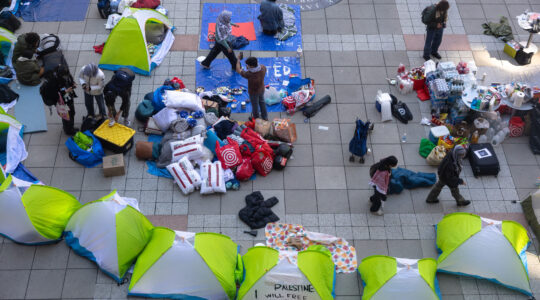(JTA) — The Metropolitan Museum of Art in New York never substantially changed its label on its exhibit of the Gertrude Stein collection, continuing to ignore the Jewish writer’s Vichy sympathies, charged a writer for the New Yorker.
Emily Greenhouse, a writer for the magazine, checked in on the exhibit in late May, after a number of Jewish figures and the Anti-Defamation League had pressured the Met to change the label. The museum disputed that characterization.
In an article posted Friday, Greenhouse said she found that the label on the Stein exhibit had only been changed superficially, and still did not fully reflect her sympathies for Vichy-era collaborationists in France, where she lived during the Nazi period.
Stein, according to Greenhouse, translated the anti-Semitic speeches of Marshal Philippe Petain, the Vichy leader, into English.
A spokesman had said at the time of the controversy the label would be changed to better reflect the historic reality. Jewish officials praised the Met for promising to make a change.
Museum officials told Greenhouse that they decided to keep the label more or less the same because they believed that Stein’s reputation as a sympathizer with Nazi-affiliated officials was based on a misconception: Stein, in a much cited 1934 interview, had told the New York Times that Adolf Hitler deserved the Nobel Peace Prize.
The interview, in context, makes it clear that Stein was attempting sarcasm.
However, Stein’s admiration expressed elsewhere for Petain and fascists like Francisco Franco of Spain, and her soft-peddling Hitler’s threat, seem to be sincere.
Stein, who was Jewish, lived in Paris during World War II and collected the artwork in the exhibit.
Her artwork was not looted by the Nazis, apparently since she enjoyed the protection of the Vichy regime — the one element of her relationship to collaborators reported in both the original and the revised labels.
The new version in the museum notes changes the description of Stein’s close friend Bernard Fay from being “an influential Vichy collaborator” who “is thought to have protected them” to a “Nazi collaborator” who “protected them.” It also added that Stein did not purchase art during the war and that the German military was “on the verge of confiscating her collection” when Allied troops arrived in Paris in 1944.
Also, the original reported that Stein had bequeathed a portrait of herself by Picasso to the Met; no relationship between Stein and the Met is reported in the second version.
Finally, the updated text notes that information on Stein’s life in German-occupied France is available in the museum gift shop.
The exhibit closed June 3.





